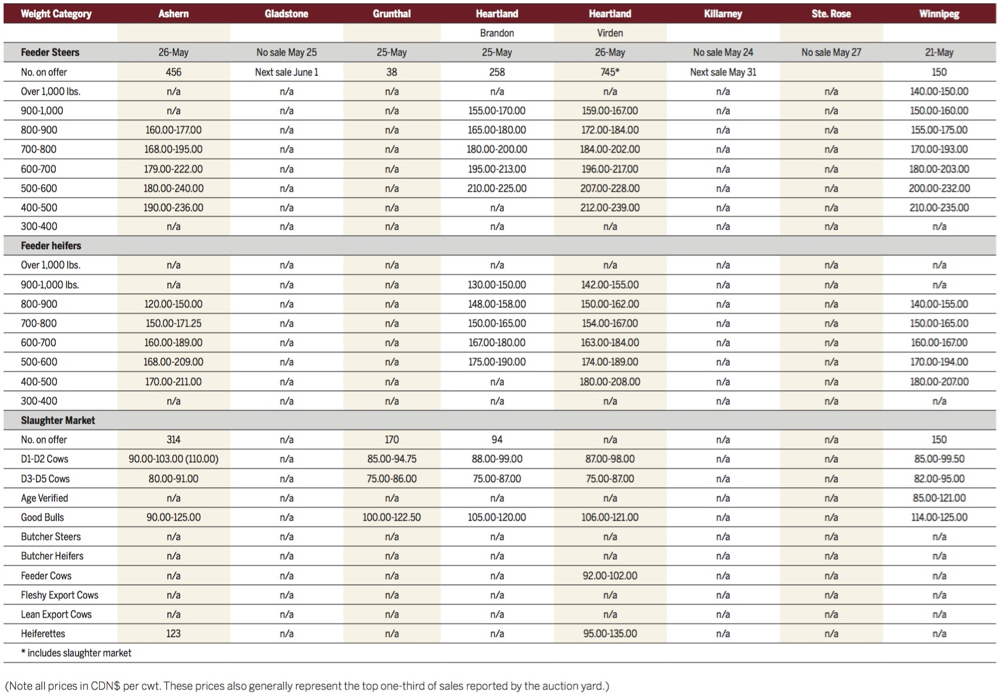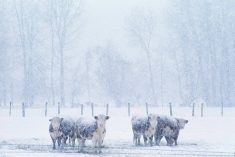It was another week of declining cattle numbers at livestock auction sites across Manitoba during the week ended May 27.
As auction sites in Gladstone, Killarney and Ste. Rose du Lac were closed for the week, only 2,375 cattle went through the rings, down from 2,426 the previous week. Of those 2,375, at least 950 were feeders.
“The quality is definitely not there. We’ve seen some bigger cattle that are still trading,” said Tyler Slawinski of Ashern Auction Mart and Gladstone Auction Mart. “Prices are still trading fairly fair; even grass cattle is fairly pricey.”
Read Also

Canadian canola prices hinge on rain forecast
Canola markets took a good hit during the week ending July 11, 2025, on the thought that the Canadian crop will yield well despite dry weather.
The high cost of feed has affected prices for feeders, he added, while the market for butcher cattle remains strong.
A wide swath of precipitation came down on much of southern Manitoba the previous week, which improved growing conditions on pastures. Slawinski mentioned there were 110 cow-calf pairs at a sale in Gladstone on May 20 after expecting only 75.
“Everybody was holding off waiting on some moisture. I guess you could say everybody got the ‘million-dollar rain.’ We’re just waiting on Mother Nature to co-operate now,” he said.
“There’s definitely a lot more optimism in the cattle industry because there’s more moisture.”
The Chicago Mercantile Exchange’s June live cattle contract closed at US$116.35 per hundredweight on May 27, in line with its month-long average. Meanwhile, its August feeder cattle contract closed at US$152.85/cwt, the day after reaching a month-long high of US$158.725.
While the rising Canadian dollar and feed prices continue to negatively affect Manitoba’s cattle market, the weather also continued to have an effect.
“People were discouraged from buying any grass cattle just because there was no grass. Now with the rain, whatever grass cattle are left are going to sell strong well into the summer markets,” Slawinski said, adding that most feeder cattle are staying local.
“I expect to see (cattle) numbers here tapering off and hopefully we get to see some grass growing and whatever cattle do go to grass, I hope they flourish. I hope there’s a terrific market to look forward to in the fall.”
The Canadian Food Inspection Agency announced May 27 the country has been recognized by the World Organization for Animal Health (OIE) as having only a “negligible risk” for bovine spongiform encephalopathy (BSE), the most preferred status in OIE’s three-tier system.
Federal Agriculture Minister Marie-Claude Bibeau marked the occasion by speaking with Stan Eby and Bob Lowe, the past and current presidents of the Canadian Cattlemen’s Association, respectively.
“Obtaining the ‘negligible risk’ status from the OIE confirms that Canada’s beef production system is sound, safe and respected,” Bibeau said in a release. “This will allow our beef and other cattle producers to expand their export markets and to develop their businesses.”
“With the OIE’s decision to grant Canada negligible risk status for BSE, today marks the historic closing of the BSE era. We thank everyone involved in helping us attain this status including the Government of Canada, veterinarians across Canada and Canadian farmers and ranchers,” Lowe said in the same release.
“We also thank Canadian consumers who supported Canada’s beef industry during the hardest times of BSE when Canadian beef couldn’t be exported.”
BSE is a progressive, fatal disease of the central nervous system of cattle. Canada detected its first domestic case in May 2003 and its most recent in February 2015.




















